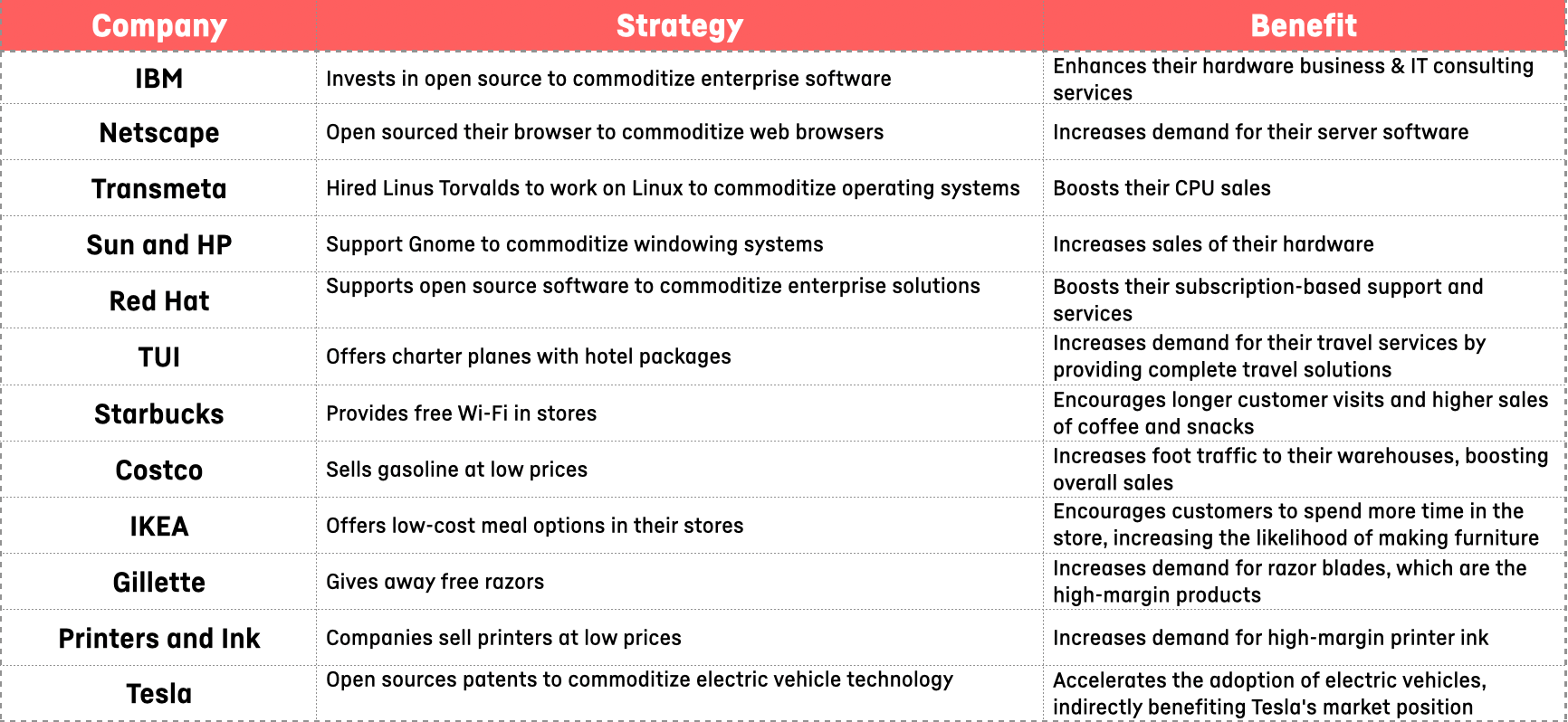Case Study: Meta's Strategy for Open-Sourcing LLaMa: A Detailed Analysis
Intro
In the past few weeks, I've encountered various perspectives on Meta's strategy for advancing their frontier large language model (LLM), Llama 3.1. This model, with capabilities comparable to GPT-4 and Claude 3.5, is now publicly available for the first time. Released by Meta under an open and permissive license, Llama 3.1 supports commercial use, synthetic data generation, distillation, and fine-tuning.

As anticipated by the open-source community, including myself, the gap between closed and open models has now been bridged, at least for the time being. This significant achievement positions Meta to lead the open AI ecosystem. The model is provided at no cost to the developer and research community, aligning with Meta's philosophy of promoting open collaboration and innovation in artificial intelligence. By removing financial barriers, Meta makes the model accessible to a wide range of users, including academia and tech startups. Large cloud vendors are probably paying Meta for the license to use Llama models, as the license is restrictive and says that companies with 700m users are required to get a commercial license, but there is no info on how big those payments could be. Llama is being criticized as LLaMa isn’t a full open-source model. If one remembers my newsletter from August 2022, I celebrated BigScience Bloom, a fully open-sourced model, that gave the community access to its code base and training data, under free licenses.
While there are no official figures on the cost of training Llama 3.1, estimates range from $35 million to $200 million. This number doesn’t include the capital expenditure cost for the 16,000 H100 GPU’s it was trained on. The Llama 3.1 405B model was trained on over 15 trillion tokens, presenting a significant challenge, making the 405B the first Llama model trained at this scale.
As I have often predicted in my posts and articles, there is no moat for those relying on closed-source LLMs. I foresee the same outcome for those investing in fully closed and proprietary egosystems, as opposed to open ecosystems. AI is becoming a common infrastructure that allows everyone to build independently, except of course if you live in a region where your government restricts access to freedom, which might become the case in Europe.
Why Meta is Open Sourcing LLaMa
Meta’s decision to open-source LLaMa can be analyzed through the lens of the microeconomic principles discussed in Joel Spolsky’s "Strategy Letter V," specifically the concepts of complements and substitutes. I wrote about this in June 2022, which was long before Meta published their first LLaMa Model.
Commoditizing Complements to Boost Core Products
- Increasing Demand for Core Products:
- Complement Relationship: For Meta, AI models like LLaMa act as complements to their core offerings, such as cloud services, hardware, and advertising platforms. By making LLaMa freely available, Meta can increase the demand for their other products.
- Lowering Costs of Complements: Open-sourcing LLaMa lowers the cost of high-quality AI tools for developers and companies, which increases the demand for Meta’s ecosystem, including their cloud services and platforms where these models are utilized. By making LLaMa freely available, Meta can also lower their R&D and operational costs, thus boosting the demand for their other products.
- Driving Adoption and Innovation:
- Network Effects: By releasing LLaMa under an open and permissive license, Meta encourages widespread adoption and innovation. This fosters a community that builds upon and improves the model, indirectly benefiting Meta by driving more usage of their infrastructure and services.
- Attracting Talent: Open-sourcing LLaMa helps Meta attract top talent in AI research and development. Talented individuals are more likely to contribute to and improve an open model, enhancing Meta’s technological leadership.
Strategic Market Positioning
- Countering Competitors:
- Competitive Differentiation: In a market where closed-source models dominate, Meta’s open-source strategy differentiates them from competitors like OpenAI and Anthropic, who maintain proprietary models. This strategic move positions Meta as a leader in open AI ecosystems.
- Reducing Rival Advantages: By commoditizing the AI model market, Meta reduces the pricing power and market dominance of competitors with closed models. This forces competitors to lower their prices or offer more value, benefitting the broader AI community.
- Creating Dependencies:
- Ecosystem Lock-In: While LLaMa itself is open-sourced, large cloud vendors and enterprises needing more comprehensive solutions might still rely on Meta for support, infrastructure, and commercial licenses. This creates a dependency on Meta’s ecosystem, ensuring a revenue stream despite the open-source nature of the model.
- Industry Standards: Promoting LLaMa as a widely adopted standard can shape industry practices and preferences towards Meta’s tools and frameworks, further solidifying their influence and control over the AI landscape.
Leveraging LLMs for Content Moderation
- Enhanced Content Moderation:
- Automated Flagging: Meta uses large language models for content moderation on platforms like Facebook and Instagram. Yann LeCun mentioned that these LLMs are crucial for automatically flagging content that might violate the platform’s terms of service. Approximately 88 percent of content removals are initially flagged by AI systems, showcasing the practical application and importance of these models.
- Operational Efficiency: Using LLaMa for content moderation improves the efficiency and effectiveness of Meta’s moderation efforts, ensuring safer platforms and enhancing user experience.
Addressing Costs and Ethical Considerations
- Cost Distribution:
- Shared Development Costs: Open-sourcing LLaMa allows Meta to distribute the cost of development and improvement across a global community. This reduces Meta’s direct investment in maintenance and innovation while benefiting from continuous advancements made by external contributors.
- Scalability: Open models scale more efficiently as they leverage collective problem-solving and innovation, making the overall ecosystem more robust and capable of handling diverse challenges and use cases.
- Ethical and Public Relations Benefits:
- Democratization of AI: By providing access to powerful AI tools, Meta promotes the democratization of AI technology, aligning with their public stance on promoting open collaboration and innovation. This enhances Meta’s image as a company committed to ethical AI development.
- Addressing Openwashing Criticisms: While some critics argue that LLaMa is not fully open source due to licensing restrictions, the open nature of the model still represents a significant step towards transparency and accessibility in AI. This helps Meta counter criticisms of openwashing and positions them favorably in the public eye.
Emphasizing the Role of Open-Source Ecosystem
Mark Zuckerberg’s Statements:
- Importance of Open Source: Mark Zuckerberg has highlighted the significance of the open-source ecosystem in the development of LLaMa models. He has emphasized that the collaborative efforts of a diverse community of developers have led to significant advancements and improvements in LLaMa models, making them more competitive and cost-effective compared to closed-source alternatives.
- Operational Cost Reduction: The open-source nature has been crucial for innovation and has helped reduce operational costs. This collaborative approach aligns with Meta’s philosophy of promoting open collaboration and innovation in artificial intelligence.
Lessons from Non-Tech Industries
Companies support open-source software not out of idealism but because it serves their business strategy. This principle applies across various industries:

A Missed Opportunity in Healthcare
One of the biggest opportunities in healthcare for pharma might be to commoditize their complement, which is the ability to diagnose and prescribe. It is surprising to see that most big pharma companies do not understand this strategy and have not started investing in building certified open-source clinical large language models. This is their absolute complement and not their core business. By investing in and open-sourcing clinical LLMs, pharma companies could significantly reduce the cost of diagnostics and prescriptions, thereby increasing the demand for their pharmaceutical products.
Conclusion
Meta’s strategy to open-source LLaMa aligns with the principles of commoditizing complements to boost demand for their core products and services. This approach not only differentiates Meta in a competitive market but also fosters innovation, attracts talent, and builds dependencies on their ecosystem. By leveraging LLaMa for content moderation and emphasizing the role of the open-source community, Meta aims to solidify its leadership in the AI space while addressing both strategic and ethical considerations.
In other industries, from travel to retail, companies have successfully employed similar strategies, highlighting a significant opportunity for sectors like healthcare to adopt these principles to their advantage.
